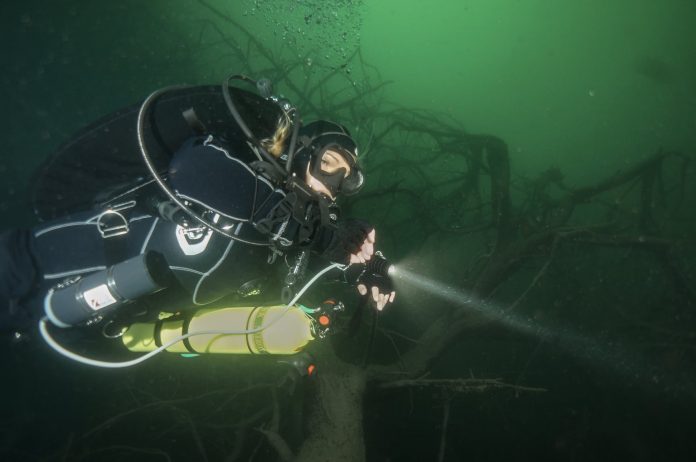
KNOWN among cave divers as the coldest sinkhole in the South East, Ela Elap is hidden in a paddock on private property in Mount Schank.
At around 11C, its water’s temperature is between two and four degrees cooler than most other waterfilled caves and sinkholes in the region.
The main feature of the sinkhole is a giant weeping willow tree that has toppled from its base at the water’s edge, crashing down the sinkhole’s 10 metre high walls to come to rest beneath the water’s surface.
Its uprooted base can be located at around 20 metres below the surface, with its entanglement of branches reaching further down.
When not frequented by divers, the finer branches are covered in what seems like a white algae which gives the huge tree a ghostly appearance when first encountered by cave divers as they make their way down.
The hole is undercut all the way around except on the south-western side where a large sloping ramp has been cut – originally to provide stock access to the water.
Directly under the overhang the top of a rock pile is reached at a depth of around 28 metres.
From there, the pile drops all around to a soft silt floor on which more tree branches can to be found.
In addition a number of interesting vertical limestone structures several metres high can be found on the walls just to the right (east) of the entry zone at a
depth of 36 metres.
Veteran cave diver and Cave Divers Association of Australia (CDAA) life member Peter “Puddles” Horne told The Border Watch the pillars “were most likely microbialites such as stromatolites and are thought to be the source of long-heard rumours of giant stalactites in the hole”.
Sometimes referred to as the Green Lake because of the grey-green colour of its water, the cenote-style sinkhole measures around 35 metres across and sinks to a depth of 50 metres on the north-eastern side.
“Its chilly water was noted by early explorers, and a sinkhole environmental research project that I and my diving mate Mark Nielsen undertook every three months in 1981/82 confirmed Ela Elap was indeed colder than any of the other local waterfilled sinkholes studied in that period,” Mr Horne said.
“Just why this is so has not yet been explained.”
Although there are various ideas about the origin of the sinkhole’s name, the most likely would appear to be the version that the hole was named after local Aboriginal words “lap lap” for small fish.
“Many cave divers think it is simply an anagram for Pale Ale or Pale Hole and some incorrectly call it ‘Eloh Elap’.
“Ela Elap was first mentioned in the records of the Cave Exploration Group of SA in a report by Bob Sexton and SR Shanks in April 1962, where it was also mentioned that the feature was first officially described by Deputy Surveyor General Thomas Burr in 1845.
“The earliest recorded dive in this sinkhole of which I am aware took place in November 1962, when local divers Jock Huxtable and Philip ‘Mick’ Potter explored it to a depth of about 47 metres,” Mr Horne said.

“Ela Elap and Little Blue sinkholes – together with One Tree sinkhole located halfway between them – are in a line of special sinkholes (called cenotes) across the Mount Schank plain,” Cave Divers Association of Australia science officer Ian Lewis told The Border Watch.
“They have formed from water dissolving large deep underground chambers along fractures of the geological Nelson Fault Line which runs from Nelson and the Piccaninnie Ponds area through Mount Schank and across the Kongorong limestone plains.
“Early settlers thought the sinkholes were volcanic vents associated with Mount Schank eruptions, but geoscientists now know the groundwater was made acidic by deep volcanic gases which caused the large underground chambers to be dissolved within the limestone until their roofs fell in to form the sinkholes of today.”
Mr Lewis said Mount Schank is about 5,000 years old, but the sinkholes are much older – between 30,000 to 130,000 years is a current estimate.
In 1844 Governor Grey’s early South East exploration expedition passed Little Blue Lake near Mount Schank and the renowned colonial artist George French Angus painted several watercolours of sinkholes discovered.
“One of his paintings thought to be of Little Blue proved to be of Ela Elap as it shows Mount Schank closer in the background,” Mr Lewis said.
“Both these sinkholes have large ramps cut at an angle down to the water for stock to drink.
“It is unclear when this work was undertaken, but pick marks and engraved names in the walls of the cuttings indicate they were cut before 1900.”
The current water level is too low for stock to drink, but rainfall records show a very wet period for several decades around the 1900s.
“Rainfall has been declining steadily for more than a century, bringing the groundwater level down with it,” Mr Lewis said.









